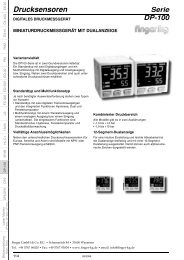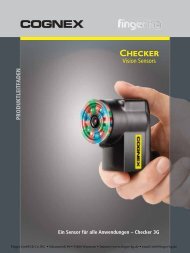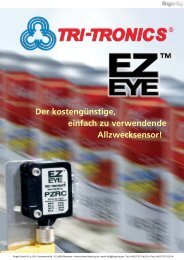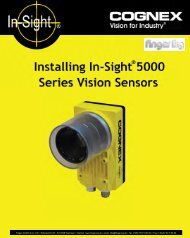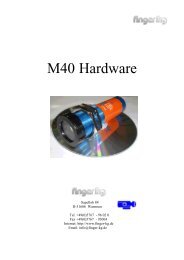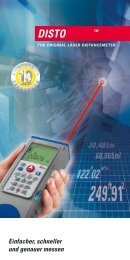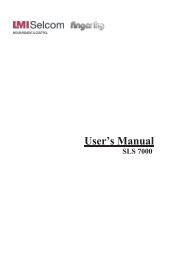TRIANGULATION LASER SENSORS, LDS603 Series Rev. G (26.06 ...
TRIANGULATION LASER SENSORS, LDS603 Series Rev. G (26.06 ...
TRIANGULATION LASER SENSORS, LDS603 Series Rev. G (26.06 ...
You also want an ePaper? Increase the reach of your titles
YUMPU automatically turns print PDFs into web optimized ePapers that Google loves.
<strong>TRIANGULATION</strong> <strong>LASER</strong> <strong>SENSORS</strong>, <strong>LDS603</strong> <strong>Series</strong><br />
Level of laser output power. By changing this parameter it is possible to switch the sensor to<br />
operation with minimum limiting time of integration (maximum operation speed) for particular surfaces.<br />
The point of z ero - sets a zero point of absolute system of coordinates in any point within the<br />
limits of a working range.<br />
The reserved parameters are used for the sens ors setting. Change of these parameters can<br />
lead to infringement of sensor calibration. Correct change of parameters is made with the help of<br />
the installation program supplied with the sensor.<br />
Page 5/22<br />
8. DESCRIPTION OF SERIAL INTERFACE (RS232 or RS485)<br />
8.1. The hardware port RS232 allows sensor to be connected directly to a computer.<br />
8.2. In accordance with the protocol accepted and hardware capability, the RS485 port makes it<br />
possible to connect up to 127 sensors to one data collection unit by a common bus circuit.<br />
8.3. Network data communications protocol assumes the presence of ‘master’ in the net, which<br />
can be a computer or other information-gathering device, and from 1 to 127 ‘slaves’ (RF603 <strong>Series</strong><br />
sensors) which support the protocol. Each ‘slave’ is assigned a unique network identification code –<br />
a device address. The address is used to form requests or inquiries all over the net. Each slave receive<br />
inquiries containing its unique address as well as ‘0’ address which is broadcast-oriented and<br />
can be used for formation of generic commands, for example, for simultaneous latching of values of<br />
all sensors and for working with only one sensor (with both RS232 port and RS485 port).<br />
8.4. Serial data transmission format:<br />
<strong>Rev</strong>. G (<strong>26.06</strong>.2008)<br />
1-start bit,8-data bits,1-odd bit,1-stop bit.<br />
Odd bit is complementary to 8-data bits for oddness.<br />
8.5. The communications protocol is formed by communication sessions, which are only initiated<br />
by the ‘master’. There are two kinds of sessions:<br />
1) ‘inquiry’,[‘message’] — [‘answer’], square brackets include optional elements<br />
2) ‘inquiry’ — 'data stream’ — [‘inquiry’].<br />
‘Inquiry’ (INC) is a two-byte message, which fully controls communication session. The ‘inquiry’<br />
message is the only one of all messages in a session where most significant bit is set at 0; therefore,<br />
it serves to synchronize the beginning of the session. In addition, it contains the device address<br />
(ADR), code of inquiry (COD) and, optional, the message (MSG).<br />
The ‘inquiry’ format: INC0(7:0),INC1(7:0) = 0,ADR(6:0),1,0,0,0,COD(3:0), [MSG].<br />
‘Message’ and ‘answer’ are data bursts that can be transmitted by ‘master’ or by ‘slave’ in the<br />
course of the session, respectively. ‘Data stream’ is an infinite sequence of data bursts or batches<br />
transmitted from ‘slave’ to ‘master’, which can be interrupted by a new inquiry. In transmission of<br />
‘data stream’ one of the ‘slaves’ fully holds data transfer channel, therefore, when ‘master’ produces<br />
any new inquiry sent to any address, data streaming process is stopped. Also, there is a special<br />
inquiry to stop data streaming.<br />
8.6. Message transfer.<br />
All messages with a message burst contain 1 in the most significant digit. Data in a message are<br />
transferred in tetrads. When byte is transmitted, lower tetrad goes first, and then follows higher tetrad.<br />
When multi-byte values are transferred, the transmission begins with lower byte. The following<br />
is the format of two ‘message’ data bursts for transmission of byte DAT(7:0):<br />
Dt0(7:0);Dt1(7:0) = 1,0,0,0,DAT(3:0);1,0,0,0,DAT(7:4).<br />
8.7. Answer transfer (for the 01h…04h enquiry codes).<br />
Finger GmbH & Co. KG • Schamerloh 84 • 31606 Warmsen • Internet: www.finger-kg.de • email: info@finger-kg.de



